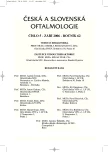The Color Doppler Ultrasonography in Glaucoma Diagnosis
Authors:
J. Čmelo 1; M. Chynoranský 2; K. Mičevová 3; T. Valášková 3
Authors‘ workplace:
Očná – neurooftalmologická ambulancia, Bratislava
1; Klinika oftalmológie LF UK, Bratislava
2; Očná ambulancia, Bratislava
3
Published in:
Čes. a slov. Oftal., 62, 2006, No. 5, p. 339-347
Overview
The insufficiency of the autoregulation at the optic nerve’s head may cause the glaucoma optic neuropathy (GON). If the long-term stressing exists and an additional endurance arises, the autoregulation may fail and significant changes of the resistance index (RI) at the central retinal artery (CRA) and at the posterior ciliar artery (PCA) can be detected by color flow ultrasonography. Resistivity index represents peripheral resistance. It is displayed in numerical value 0–1. 0 indicates none peripheral resistance, 1 indicates maximal peripheral resistance.The goal of this paper was to determine a risk value of the RI at the CRA and PCA that could suggest possible damaging of the optic nerve.
Two groups of the patients were evaluated in the course of 4 years duration of the study. In the I. Group were 72 patients (144 eyes) with GON and with intraocular pressure (IOP) 14–24 mm Hg. The II. Group consisted of 25 healthy men (48 eyes) without diagnosis of GON and with IOP values 14 – 20 mm Hg. There were RI measurements at all patients at the CRA and CPA at the idle mode and immediately after ordinary addition endurance (performing squatting – Master test). The statistical analysis by T test was evaluated with value: 0.05.
Conclusion:
According to our findings, the difference between RI: 0.12 ± 0.03 at the CRA at the idle mode and immediately after ordinary addition endurance is significant for damaging of the autoregulation at the optic nerve’s head. For assessment of the insufficiency of the autoregulation at the optic nerve’s head RI from PCA is not significant.
Key words:
color flow ultrasonography, glaucoma
Labels
OphthalmologyArticle was published in
Czech and Slovak Ophthalmology

2006 Issue 5
Most read in this issue
- The Use of Accommodative Lenses for Surgical Correction of the Presbyopia Using the Prelex Method
- Clinical Appearance and Outcome of Zone 1 ROP
- Ocular Symptoms as an Indication for Carotid Endarterectomy
- The Quality of Vision in Premature Infants – First Results
